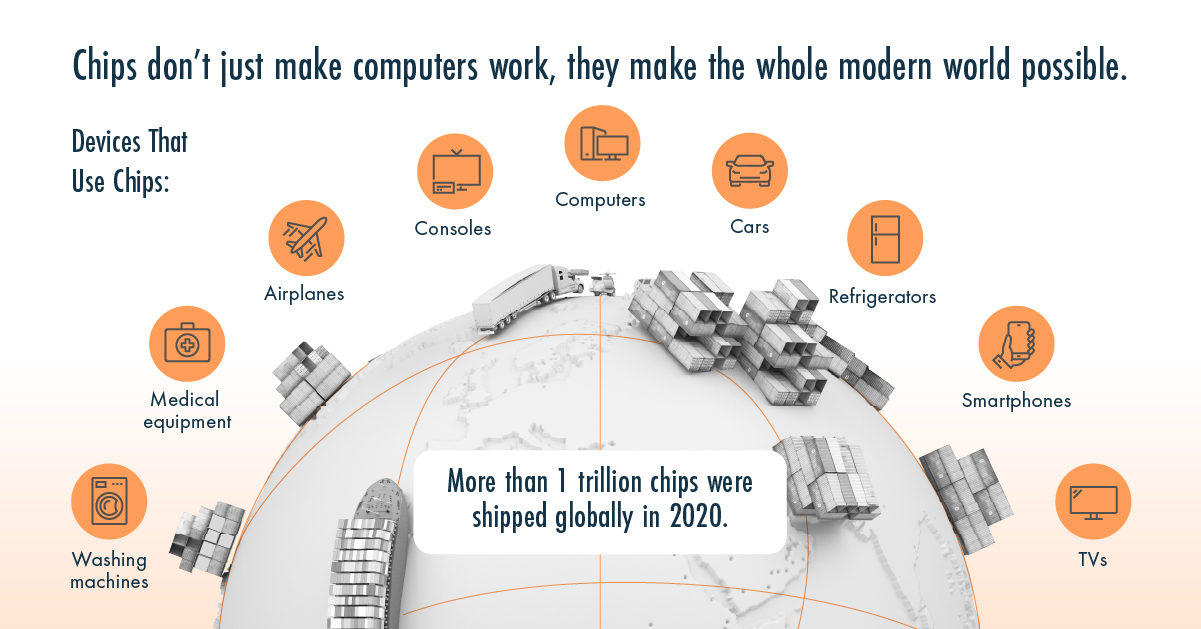How to Invest in the Booming Chip-Tech Industry
The following content is sponsored by eToro

Investing in the Chip-Tech World
How much of the modern world is powered by chip-tech? From computers and TVs to cars and washing machines, chips (or semiconductor devices) enable almost all of our digital goods.
When the COVID-19 pandemic brought the regular world to a halt, it put a focus on our increasingly digital world and personal electronics. Even as consumption of major purchases like vehicles slowed down, more than 1 trillion chips were shipped globally in 2020.
As economies picked up and demand increased across all goods, a global semiconductor shortage started to impact the largest companies and economies in the world. All of a sudden, the global semiconductor field was front-and-center in the minds of politicians, executives, and investors.
This graphic from eToro breaks down the importance of the semiconductor industry, and where moves are being made in it.
Understanding the Semiconductor Supply Chain
At its core, a chip or integrated circuit (IC) is a small device that contains electronic circuits on a semiconducting material.
Only a few millimeters wide, these chips (usually constructed on silicon) have millions of transistors packed into a tiny device. When designed and utilized together, they power devices and allow them to operate.
It’s a complex device that requires an extremely robust manufacturing system, capable of making millions of precisely designed products. The modern semiconductor supply chain has two primary business models:
- Foundry model: Also known as fabless design, companies like NVidia and Qualcomm outsource production of chips to fabrication foundries like TSMC. They are then assembled and tested by specialty companies (OSATs) before being received by the end consumer.
- Integrated model: Integrated device manufacturers (IDMs) are companies like Intel that design, manufacture, and sell their own chips. This was the traditional model of chip development before foundries took off, and many IDMs now outsource part of their production to foundries and OSATs.
As demand for semiconductor devices grew, a massive and sophisticated global supply chain formed to get chips from concept to consumer.
| Market Share by Region | IDM | Fabless | Foundry | Wafer Production |
|---|---|---|---|---|
| U.S. | 51% | 65% | 0% | 13% (North America) |
| South Korea | 29% | 1% | 18% | 20% |
| Taiwan | 2% | 17% | 63% | 21% |
| Japan | 9% | <1% | 0% | 16% |
| China | <1% | 15% | 6% | 15% |
| Europe | 9% | 2% | 0% | 6% |
| Rest of World | 0% | 0% | 13% | 9% |
Many of the pioneering companies in the field, like Taiwan’s TSMC and South Korea’s Samsung, became some of the world’s largest and most influential companies.
Anticipating the Chip-Tech Powered Future
The global economic impact of the semiconductor field is monumental, and its breadth is quickly becoming better understood.
In the U.S. alone in 2020, the semiconductor industry contributed an estimated $246.4 billion to the country’s GDP and almost 2 million jobs. When measuring direct, indirect, and value-added impacts of semiconductors, global GDP contribution estimates come in at $2.7 trillion.
But more than ever, recent disruptions to the supply chain have raised alarm bells and increased investment. Slashed forecasts from automakers and electronics manufacturers are increasing demand for chip production capacity, and chipmakers have already announced investments for new factories in 2021:
| Company | Announced Fab Investment (2021) | Fab Location |
|---|---|---|
| TSMC | $12B–$35B | U.S. (Arizona) |
| Intel | $20B | U.S. (Arizona x2) |
| Intel | $20B | Europe |
| Samsung | $17B | U.S. (Texas) |
| GlobalFoundries | $4B | Singapore |
And those six factories are just the beginning. Over the next two years, 29 fabrication factories are projected to be constructed globally, with total investment surpassing $140 billion.
Policymakers are stepping in as well, as countries race to increase market share in case of further disruptions. In June, the U.S. Senate passed a $250 billion tech and manufacturing bill with $52 billion earmarked for the semiconductor field specifically.
The timing is imperative, as an even more chip-dependent future continues to unfold. Driven by advances in 5G, A.I. and IoT in everything from automotive and electronics manufacturing to smart factories, chip-tech and investments in it are becoming more important than ever.
How Can Investors Take Part?
eToro’s Chip-Tech CopyPortfolio* gives investors direct access to the semiconductor technology market.
Curated by experienced and proven investment teams, the thematic portfolio offers exposure to a broad range of chip-makers and innovators in production, with no management fees.
*Your capital is at risk.
CopyPortfolios is a portfolio management product, provided by eToro Europe Ltd., which is authorised and regulated by the Cyprus Securities and Exchange Commission.
CopyPortfolios should not be considered as exchange traded funds, nor as hedge funds.
-

 Sponsored3 years ago
Sponsored3 years agoMore Than Precious: Silver’s Role in the New Energy Era (Part 3 of 3)
Long known as a precious metal, silver in solar and EV technologies will redefine its role and importance to a greener economy.
-

 Sponsored7 years ago
Sponsored7 years agoThe History and Evolution of the Video Games Market
Everything from Pong to the rise of mobile gaming and AR/VR. Learn about the $100 billion video games market in this giant infographic.
-

 Sponsored8 years ago
Sponsored8 years agoThe Extraordinary Raw Materials in an iPhone 6s
Over 700 million iPhones have now been sold, but the iPhone would not exist if it were not for the raw materials that make the technology...
-

 Sponsored8 years ago
Sponsored8 years agoThe Industrial Internet, and How It’s Revolutionizing Mining
The convergence of the global industrial sector with big data and the internet of things, or the Industrial Internet, will revolutionize how mining works.


